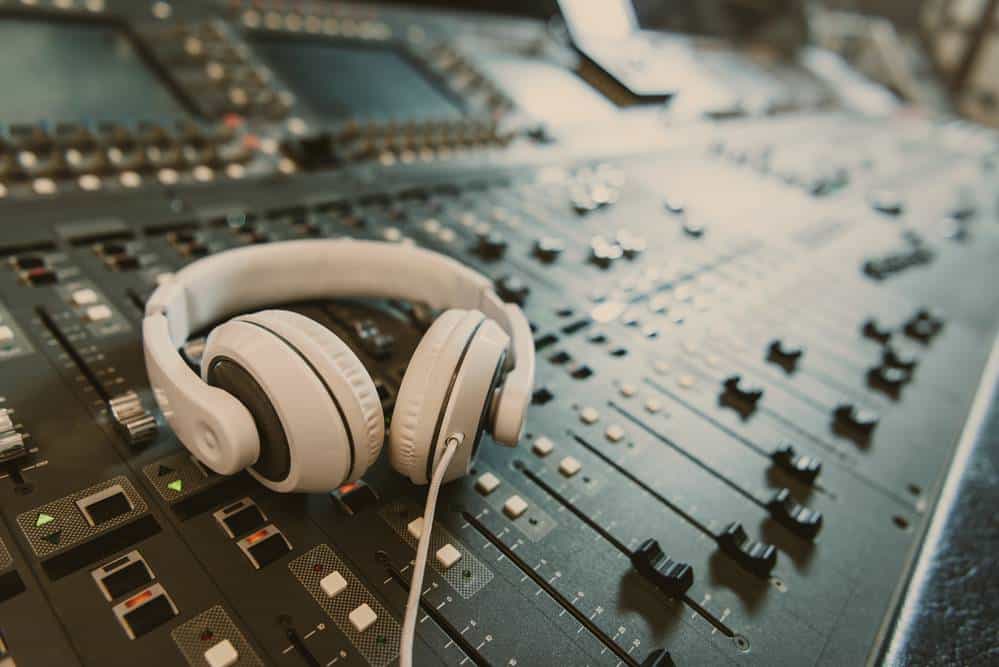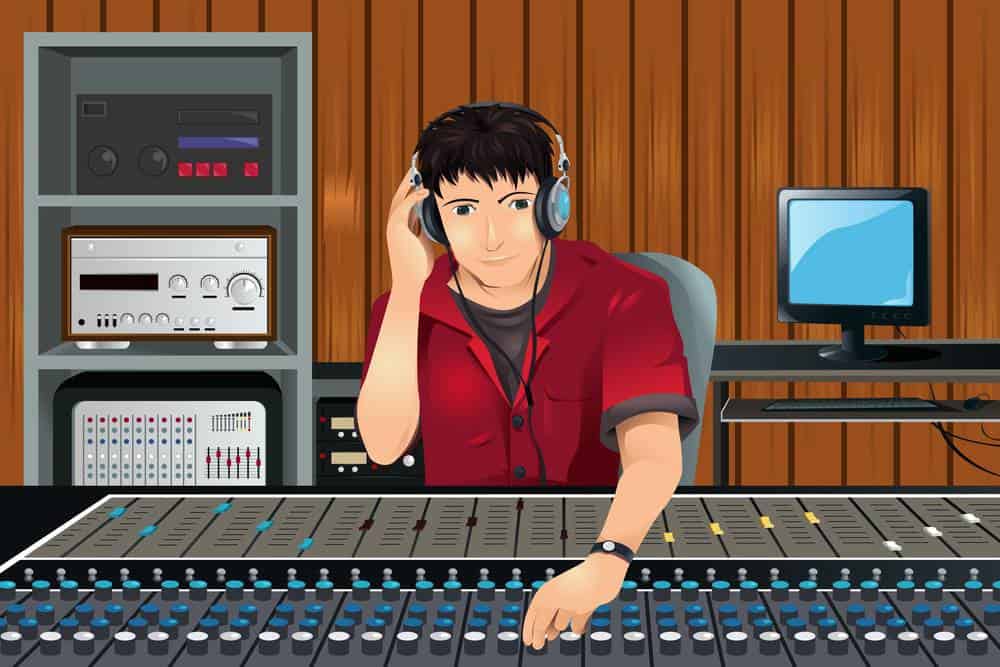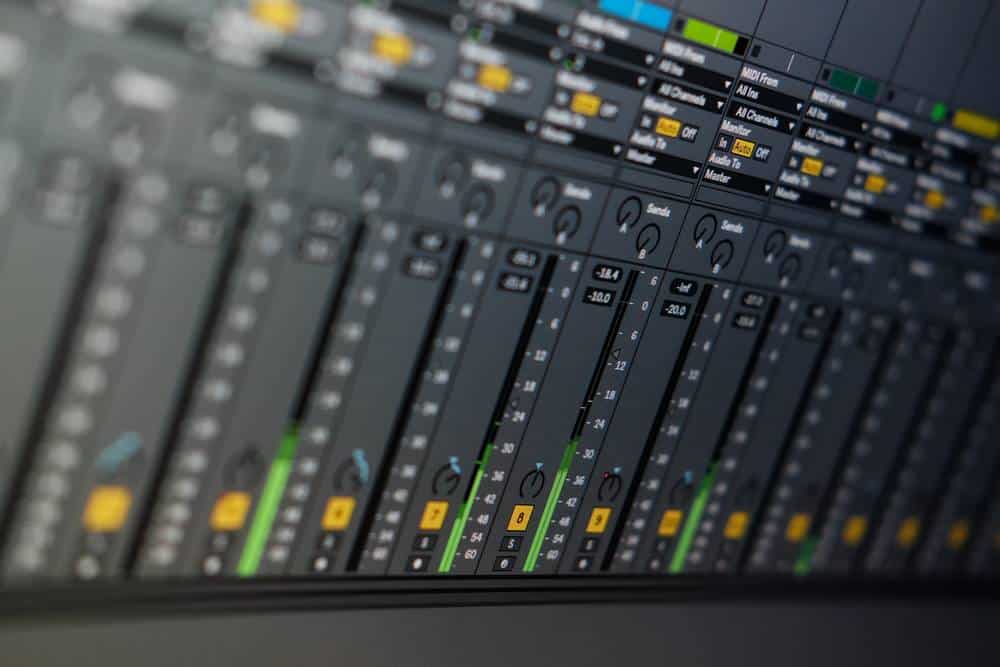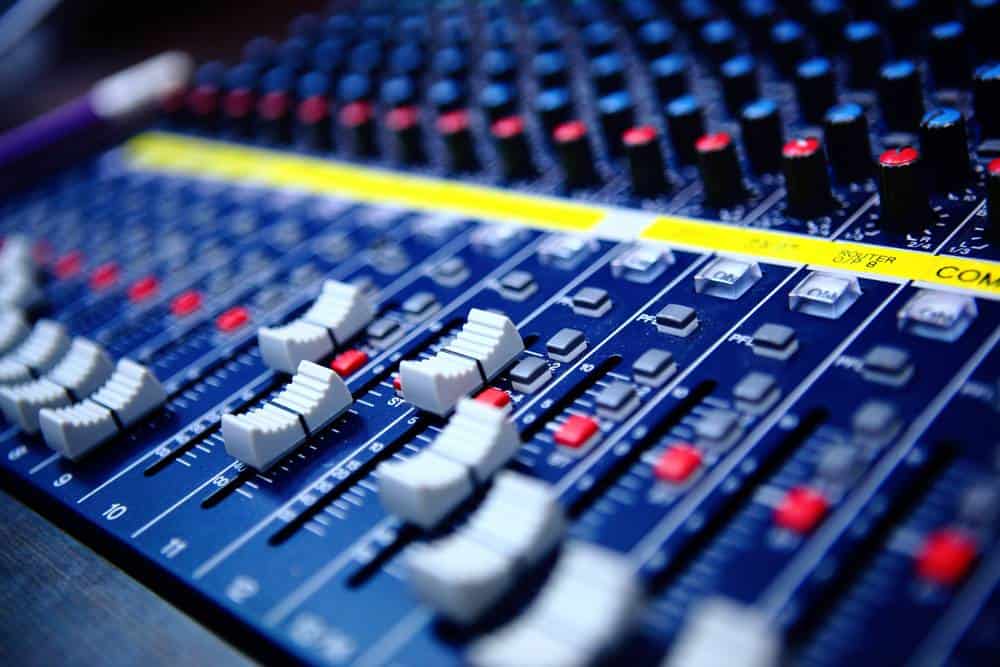Last Updated on June 20, 2021 by Danny
Music production can be a complex and daunting task. There are so many different components that go into the process, from writing the song to recording it in a studio. This article will cover everything you need to know about music production.
One of the most important aspects of being a successful musician is knowing how to produce your own music. So you’ve got an idea, and now it’s time to turn that into something more tangible. In this article, we’ll give you a crash course in music production: what it entails, how to start doing it yourself (even if you don’t have any previous musical experience), and even some free software options for getting started!
What is Music Production?
Music production is the process of creating a song. While it includes many different elements, here are the major steps in general.

Composing: Brainstorming for an idea and figuring out how to translate that into music – Songwriting: writing lyrics or melody lines – Recording: capturing musical ideas on audiotape (or digital recorder) – Sound design: manipulating sound, usually with digital tools – Mixing: combining different elements of the song to create a cohesive final product – Mastering: adjusting volume and adding effects for optimal listening.
These days, many professional studios also offer video production services. You can learn more about each step in our blog post on What is music production?
Recording: Capturing musical ideas on audiotape (or digital recorder). Recording ideas onto tape or digitally recording them can be accomplished through using microphones and your computer’s sound card.
Sound design: Manipulating sound, usually with digital tools. Sound design manipulation of sound, usually with digital tools, includes the use of effects such as distortion, delay, reverb, and more to create original sounds manipulated in many different ways – i.e., pitch shifting, time-stretching, etc.
Mixing: Combining different elements of the song to create a cohesive final product. Mixing combining elements of a song into one cohesive final product is done by adjusting volume levels adding effects like EQ compression panning delays filters echo flanging that will optimize listening production.
Mastering: Adjusting volume and adding effects for optimal listening. Mastering the last step in production is to prepare a song for distribution. This includes adding metadata, like copyright information or album art, as well as adjusting volume levels so that it’s consistent with other songs on an album.
Producing: Overseeing all the different stages and making sure they are running smoothly – Musician: someone who can read music, play an instrument, or sing
Digital tools are the most popular method of producing music because they are inexpensive, easy to make mistakes and fix with software features and allow for a lot more creativity.
Set up a home studio: Setting up your computer with digital tools to create high-quality recordings, mixing, and mastering on your own. It takes time to learn, so be patient!
Basic information about Music Production includes everything from composing lyrics or melody lines, recording musical ideas onto audio tape (or digital recorder), sound design manipulation of sound usually with digital tools, mixing combining different elements of the song into one cohesive final product through adjusting volume adding effects for optimal listening production overseeing all the various stages and making sure things run smoothly musician somebody that reads music plays instruments and writes songs for an artist.
What does a Music Producer do?
A music producer is an individual who brings artistic and technical skills to the process of creating, shaping, mixing, or mastering sound recordings. They work with performers in recording studio settings such as bands or solo artists.

In contemporary arts popular culture contexts, they are typically called record producers with much broader responsibilities than those on a traditional classical label budgeting for albums, at a minimum. One would have broad responsibility for all parts of marketing, including promotion, publicity, and album sleeve design.
A music producer has various roles that may include functions like creative input into musical content (notes) and more practical ones like advising musicians artistically during rehearsals before recording sessions, employing musicians and recording engineers during sessions, or organizing the recordings with an arranger.
A music producer is often a musician, but they are not required to be one. Instead, their main job is to decide what should go on in the studio based on sound advice from persons such as session players who may have years of experience playing live concerts. As you can see, producers need to know how to create certain sounds within any genre that they work in.
In EDM (electronic dance music) production roles span anywhere between composing original tracks, remixing other people’s songs, and DJ’ing at large festivals like Ultra Music Festival Miami where DJs perform sets of electronic music along with vocalists singing over the music. In R&B and hip-hop production, a producer’s primary role is to make the sounds that are used in their tracks by playing instruments or using sound samples from other artists’ songs.
A good way for producers to get creative input would be through regularly reading blogs like this one about different ways people create new musical styles with technology such as EDM (electronic dance music). Keeping up on trends in popular genres will help them stay updated on what types of equipment they need to buy, which sample packs work best within certain types of productions, etcetera.
Software and Equipment needed to Produce Music
To produce music you will need the following:
– A computer with a sound card and speakers.
This is where all of your sounds are created, mixed, and stored. It also provides storage for any loops or samples that might be used in your song. You’ll want one that can handle multitasking with ease if you plan on using multiple tools at once.
– An Audio Interface:
Suppose you’re looking to record vocals as well. In that case, this device converts analog signals from microphones into digital ones so they can go straight into the computer without being distorted by external noise like traffic outside your studio space. There’s no point in having a DAW-less interface because it doesn’t have the necessary inputs to plug in a mic.
– A DAW- Digital Audio Workstation:
This is the main program you’ll use when making music, and it’s where all of your sounds are saved onto your computer. It has everything from changing sound levels to different types of synths, drum machines, and other production tools. Ableton Live or FL Studio will be good examples if you’re looking into purchasing one. Once again, there’s no point in having an interface without a DAW because they work together hand-in-hand.
Other Production Tools include Synths (like the Roland JUNO), Drum Machines (Ableton Push), groove boxes, Reverb, Delay, and much more.
A good pair of headphones let you listen to your sounds as they come back from the computer without any feedback or interference. You’ll also need a mic for recording vocals or instruments if that’s what you’re trying to do in your music production setup.
Ableton Live: This is an audio workstation software that DJs use to mix songs, but it has many other features such as sound effects, synthesizers, drum machines, and looping tools, let which make it great for producing on-the-go compositions! It works well with MIDI controllers like the Push (seen below) because there are preloaded clips already made by Ableton engineers ready at hand when needed.
The 10 Best Drum Machines on the Market Today
Producing Music in a DAW
Your DAW is your digital home. It’s a place that you can go to when the outside world gets too noisy, and it needs to stay like this. You need a space where you feel comfortable experimenting with soundscapes and melodies so that creativity is just an arm’s length away at all times.

You may not know exactly how music production works in general, but chances are good that you’ve already been doing some of it without realizing it. The best way for beginners to learn about music production techniques is by listening closely to what they’re hearing on their favorite tunes from bands or musicians they admire.
Because if somebody else did something interesting enough for them to notice, then chances are there’s more going on than meets the eye.
In a traditional recording studio, music production workflow starts with the producer creating loops and clips of their ideas in order to get them down onto paper (or into computer software). This is known as structuring isolated fragments, which are then full arrangements.
This task is typically done by producers collectively called arrangers. In lieu of arranging parts for a band or orchestra, they’re recreating an idea from scratch using disparate elements like guitars, drums, and vocals recorded live on different tracks.
The big difference between producing hip-hop beats and classical compositions?
There’s no set arrangement when it comes to jazz or experimental sounds because any sound can be used at any time during production; there’s not even predetermined instrumentation that needs to be followed.
I know it can seem daunting to get started when you’re just starting out, but that’s why we put together this comprehensive guide on how to produce music and learn the basics. We go over everything from making beats in your DAW to mixing and mastering – all without any jargon or confusing industry terms!
Songwriting and Composition: Create a song
The process of songwriting and composition is not an easy one. There are a few different ways to compose, but they all require time and patience in order to be successful. Let’s look at the most popular ones:
- Composing with sheet music
- Recording yourself playing instruments or singing into software;
- Then using that recording as your starting point for creating a new piece based on what you played or sang!
This can lead to some really creative pieces – it even has its own name “sketch-composition.” I find this method easier than composing by writing notes because when we write down notes, our hands need to keep up with our brains, which usually doesn’t work too well. Sketches allow our hands to be the first thing that creates the music.

Inventing your own tune – This is a really fun way of composing! You can come up with melodies or riffs and then think about how they might fit together with other parts you like. If you’re unsure, take some time to make charts on paper so that there’s less room for mistakes!
Another great advantage of this method is it will teach us scales which are very useful in every kind of composition.
It takes patience and practice (I know I sound like a broken record), but if we keep practicing our craft, becoming successful as composers become more likely. And who doesn’t want that?
Sound Design: Build the sound you hear in your head
The first step in music production is to make the sound you want. This requires knowledge of synthesis, recording, and mixing techniques.
To do this, a producer needs to know what type of sounds they are looking for and how that particular sound will be used within the song.
Are these drums meant to create suspense or set an upbeat tone?
Do I need more bass frequencies or treble frequency ranges on my vocal sample?
These questions are just some considerations when it comes time to build your desired sonic palette with all its accompanying textural qualities (e.g., synth pads should have lower resonant frequencies). In essence, producers must choose which instrumentation and sound effects to use in order to create the type of mood they want.
Samples, Plugins and MIDI – Your digital sound tools are important
How can you create high-quality sounds without a perfect knowledge of instruments and rhythms? Samples, plugins, and MIDI are your digital sound tools. They give you the possibility to produce great-sounding music with little or no musical skills at all.
You don’t need expensive hardware like synths or drum machines anymore in order to make professional-sounding beats – all samples and plugins come free nowadays! You’re able to choose from countless virtual synthesizers as well as different types of Racks that work as plug-in effects for your DAW (Digital Audio Workstation). Software is constantly evolving so it’s getting cheaper every day.
There are many reasons why people use these tools because they simplify the production process: It creates new possibilities and is the perfect way for musicians with limited skills to produce music.
Recording audio tracks is another massive pillar of music production
Audio recording is the process of capturing sound waves onto a medium. Recording audio tracks for music production can be done on almost any device with access to input and output, such as microphones or speakers. The most common technology used for this task is analog tape machines (such as reel-to-reel), but since digital devices have largely replaced these in recent years, they will not be discussed here.
Digital recording methods include various computer programs and software packages (e.g., Logic Pro X) which allow computers with sufficient power to function like large format studio recorders, minimizing noise interference from outside sources while maximizing quality and speed of production.
The three main types of recordings you may want to make in a studio are:
- Voiceover/narration (e.g., the voice of the narrator)
- The instrumental performance or pre-recorded music (e.g., guitar, piano solo)
- Sound effects and other recorded soundscapes (e.g., abstract background noise) make scenes feel more realistic).
Mixing music: Blend your sounds together

Mixing music is the 2nd last stage of a production process. There are two methods for mixing:
A) Live-mixing which involves combining sounds played by musicians in real time or
B) Pre-production, where you mix an individual instrument before adding it to your audio file. Both processes can be used at different points throughout the production process and without both being present, there will not be any sound!
Cleaning up space from unwanted noise such as hiss or feedback: Adjusting volume levels between instruments so all parts have an equal impact but still retain their own character (e.g., drums should never drown out vocals). This might involve changing EQ settings like high pass filters on certain frequencies that may not need to be heard.
Achieving a blend of sounds by adjusting the balance between instruments so that all parts are audible and none sound too loud, called “balancing”. One common way to achieve this is with volume faders on an audio mixer.
In some cases, equalization or compression may need to be used as well in order to keep certain frequencies from overloading and/or dominating other ones which could result in distortion. These processes might also cause unwanted noise if they don’t have enough headroom (e.g., when using low-pass filters).
Adding effects such as reverb, delay and chorus for creative purposes:
A dry monaural microphone signal can often benefit from being panned hard left or right in mono, and then reverbed mono signals fed into a stereo reverb unit can be sent to the opposite side.
The right amount of effects processing: Too much may sound unpleasant, but too little will not add anything new or interesting.
Finalizing your mix: Making sure everything is at its correct volume level by balancing all the tracks so that they are audible without one dominating another; adjusting panning positions in order to make each instrument more distinct from others; adding any last-minute tweaks like reverberation and/or special effect(s); using high pass filter if low frequencies cause overload problems (e.g., bass guitar)
Music mastering: the definitive version of your song
Music mastering is the process of making a song sound good on all types of audio systems, from high-end audiophile equipment to cheap earbuds.
It’s an important step in manufacturing your music and can make or break how listeners hear it for years. While some tricks you can employ while mixing might help with issues such as frequency balance, what needs fixing often won’t be apparent until after mastering has been done.
That means if your mix isn’t up to par before you send it out for mastering, don’t expect much better results afterward. It’s best to get things right at the beginning so you don’t have any unwelcome surprises later down the line when everything comes together nicely but still ends up sounding bad.
A good way to make sure your mix is ready for mastering is by listening back and making a note of the EQ settings, volume levels, panning positions and any effects you might have used. If any specific notes need addressing, such as when an instrument has too much resonance in one frequency or if it sounds shrill, then correct them before sending off your track.
If possible record yourself playing the song so you can listen to playback through different monitors (or headphones) as well – ideally including some high end ones such as Tannoy speakers which will give more accurate results than cheaper brands. Unless you’re only going for mp-quality stereo audio this should be standard practice because even though mp files sound fine on mp players, when they’re listened to on a hi-fi stereo system you’ll likely notice things that should’ve been corrected.
Some people also choose to master their own tracks but it’s not something I’d recommend unless you know what you’re doing with the tools in your DAW because there are so many choices and options that can be overwhelming without someone who already knows how to use them telling you which ones work best for specific tasks.
I hope this has given some basic insight into mastering and once again if any music production questions come up feel free to get in touch about anything related!